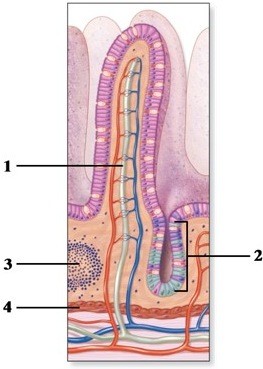Blood pressure is determined by
A) measuring the size of the pulse.
B) listening carefully to the pulse.
C) estimating the pressure needed to close off an artery with an external pressure cuff.
D) estimating the degree of turbulence in a partly closed vessel.
E) measuring the force of contraction of the left ventricle.
C
You might also like to view...
 This figure shows an intestinal villus. What specific layer does number 4 indicate?
This figure shows an intestinal villus. What specific layer does number 4 indicate?
A. Muscularis mucosae B. Lamina propria C. Circular layer of muscularis D. Basement membrane E. Longitudinal layer of muscularis
The force that causes tissue fluid to enter lymphatic capillaries is
A. Osmotic pressure B. Blood pressure C. Filtration pressure D. Hydrostatic pressure
Henry's law states that
A) gas volume and temperature are directly proportional. B) gas volume and pressure are inversely proportional. C) the volume of gas that will dissolve in a solvent is proportional to the partial pressure of that gas. D) in a mixture of gases such as air, the total pressure is the sum of the individual partial pressures of the gases in the mixture. E) gas pressure is inversely proportional to gas volume.
The presence of ketone bodies in the urine indicates increased metabolism of
A. amino acids. B. lactic acids. C. fatty acids. D. nucleic acids. E. citric acids.